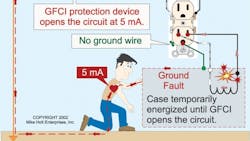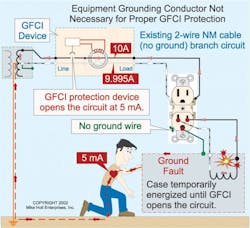You may know in what situations the NEC requires you to install a ground-fault circuit interrupter (GFCI), but do you know how it works? A GFCI is specifically designed to protect people against electric shock from an electrical system, and it monitors the imbalance of current between the ungrounded (hot) and grounded (neutral) conductor of a given circuit. Don't let the name confuse you — these devices will operate on a circuit that does not have an equipment-grounding conductor.
With the exception of small amounts of leakage, the current returning to the power supply in a typical 2-wire circuit will be equal to the current leaving the power supply. If the difference between the current leaving and returning through the current transformer of the GFCI exceeds 5mA, the solid-state circuitry opens the switching contacts and de-energizes the circuit.
However, a GFCI doesn't give you a license to be careless. Severe electric shock or death can occur if you touch the hot and neutral conductors in a GFCI-protected circuit at the same time because the current transformer within the protection device won't sense an imbalance between the departing and returning current and the switching contacts will remain closed.
In addition, GFCI protection devices fail at times, leaving the switching contacts closed and allowing the device to continue to provide power without protection. According to a 1999 study by the American Society of Home Inspectors, 21% of GFCI circuit breakers and 19% of GFCI receptacles inspected didn't provide protection, leaving the energized circuit unprotected. In most cases, damage to the internal transient voltage surge protectors (metal-oxide varistors) that protect the GFCI sensing circuit were responsible for the failures of the protection devices. In areas of high lightning activity, such as southwest Florida, the failure rate for GFCI circuit breakers and receptacles was over 50%!
GFCIs will also fail if you wire them improperly. The most important thing to remember when wiring them is to connect the wire originating at the breaker to the line side of the GFCI and the wire connecting downstream to the load side of the device. The GFCI terminals are clearly marked “Line” and “Load.” As an added safety improvement, one manufacturer markets a 15A, 125V receptacle with a built-in line-load reversal feature that prevents the GFCI from resetting if the installer mistakenly reverses the load and line connections.
One final thought on GFCI protection: Press the test button of the protection device to ensure it turns off the power to the connected load. You should do this whenever you install one, but also before relying on it to protect you when using it. Do not assume a GFCI protection device is operational unless you properly test it!
About the Author

Mike Holt
Mike Holt is the owner of Mike Holt Enterprises (www.MikeHolt.com), one of the largest electrical publishers in the United States. He earned a master's degree in the Business Administration Program (MBA) from the University of Miami. He earned his reputation as a National Electrical Code (NEC) expert by working his way up through the electrical trade. Formally a construction editor for two different trade publications, Mike started his career as an apprentice electrician and eventually became a master electrician, an electrical inspector, a contractor, and an educator. Mike has taught more than 1,000 classes on 30 different electrical-related subjects — ranging from alarm installations to exam preparation and voltage drop calculations. He continues to produce seminars, videos, books, and online training for the trade as well as contribute monthly Code content to EC&M magazine.

